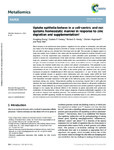Uptake epithelia behave in a cell-centric and not systems homeostatic manner in response to zinc depletion and supplementation
| dc.contributor.author | Zheng, D | |
| dc.contributor.author | Feeney, GP | |
| dc.contributor.author | Handy, Richard | |
| dc.contributor.author | Hogstrand, C | |
| dc.contributor.author | Kille, P | |
| dc.date.accessioned | 2016-06-22T16:08:05Z | |
| dc.date.available | 2016-06-22T16:08:05Z | |
| dc.date.issued | 2014 | |
| dc.identifier.issn | 1756-5901 | |
| dc.identifier.issn | 1756-591X | |
| dc.identifier.uri | http://hdl.handle.net/10026.1/4951 | |
| dc.description.abstract |
Much remains to be understood about systemic regulation of zinc uptake in vertebrates, and adequate zinc status is far from always achieved in animals or human. In addition to absorbing zinc from the diet, fish are able to take up zinc directly from the water with the gills. This provides an elegant system to study zinc uptake, how it relates to zinc status, and the expression of genes for proteins involved in zinc acquisition. A 21-day experiment was conducted in which zebrafish were acclimated to deficient, control or excess zinc concentrations in the water and feed. Deficient provision of zinc reduced whole body zinc, potassium, sodium and calcium levels whilst zinc concentrations in the uptake epithelia (gills and gut) remained unchanged. Excess levels of zinc caused accumulation of zinc in the gills, intestine and carcass, but impaired whole body iron, sodium and calcium concentrations. Fish subjected to zinc deficiency had, surprisingly, a reduced zinc influx across the gill epithelium, even when tested at a high concentration of zinc in the water. Zinc influx in the excess group was indistinct from the control. Expression of genes for metallothionein-2 (Mt2) and zinc transporters-1, -2, and -8 (Znt1, Znt2, Znt8) in uptake epithelia showed in general a direct relationship with zinc supply, while mRNA for Zip4 was inversely related to zinc supply. Transcripts for the epithelial calcium channel (Ecac/Trpv6) showed time-dependent increased expression in the gills of the deficiency group, and a transient decrease of expression during zinc excess. Transcriptome profiling by microarrays showed that in both gills and intestine, the most markedly affected biological functions were those related to cell growth, proliferation and cancer, closely followed by processes of gene transcription and protein synthesis in general. Whilst changes in zinc supply had profound effects in the intestine on genes associated with uptake and metabolism of macronutrients, many of the unique categories of genes preferentially regulated in the gill could be mapped onto signalling pathways. This included pathways for PPAR/RXR, LXR/RXR, ATM, chemokine, and BMP signalling. Overall, the responses of epithelial tissue to zinc deficiency and excess are best explained by local epithelial homeostasis with no evidence of systemic control. | |
| dc.format.extent | 154-165 | |
| dc.format.medium | ||
| dc.language | en | |
| dc.language.iso | eng | |
| dc.publisher | Oxford University Press (OUP) | |
| dc.subject | Analysis of Variance | |
| dc.subject | Animals | |
| dc.subject | Carrier Proteins | |
| dc.subject | Cluster Analysis | |
| dc.subject | Gills | |
| dc.subject | Homeostasis | |
| dc.subject | Intestinal Mucosa | |
| dc.subject | Metallothionein | |
| dc.subject | Oligonucleotide Array Sequence Analysis | |
| dc.subject | Principal Component Analysis | |
| dc.subject | Protein Isoforms | |
| dc.subject | Reverse Transcriptase Polymerase Chain Reaction | |
| dc.subject | Time Factors | |
| dc.subject | Transcriptome | |
| dc.subject | Zebrafish | |
| dc.subject | Zebrafish Proteins | |
| dc.subject | Zinc | |
| dc.title | Uptake epithelia behave in a cell-centric and not systems homeostatic manner in response to zinc depletion and supplementation | |
| dc.type | journal-article | |
| dc.type | Journal Article | |
| dc.type | Research Support, Non-U.S. Gov't | |
| plymouth.author-url | https://www.webofscience.com/api/gateway?GWVersion=2&SrcApp=PARTNER_APP&SrcAuth=LinksAMR&KeyUT=WOS:000328891100016&DestLinkType=FullRecord&DestApp=ALL_WOS&UsrCustomerID=11bb513d99f797142bcfeffcc58ea008 | |
| plymouth.issue | 1 | |
| plymouth.volume | 6 | |
| plymouth.publication-status | Published online | |
| plymouth.journal | Metallomics | |
| dc.identifier.doi | 10.1039/c3mt00212h | |
| plymouth.organisational-group | /Plymouth | |
| plymouth.organisational-group | /Plymouth/Faculty of Science and Engineering | |
| plymouth.organisational-group | /Plymouth/Faculty of Science and Engineering/School of Biological and Marine Sciences | |
| plymouth.organisational-group | /Plymouth/REF 2021 Researchers by UoA | |
| plymouth.organisational-group | /Plymouth/REF 2021 Researchers by UoA/UoA06 Agriculture, Veterinary and Food Science | |
| plymouth.organisational-group | /Plymouth/Research Groups | |
| plymouth.organisational-group | /Plymouth/Research Groups/Marine Institute | |
| plymouth.organisational-group | /Plymouth/Users by role | |
| plymouth.organisational-group | /Plymouth/Users by role/Academics | |
| dc.publisher.place | England | |
| dc.identifier.eissn | 1756-591X | |
| dc.rights.embargoperiod | Not known | |
| rioxxterms.versionofrecord | 10.1039/c3mt00212h | |
| rioxxterms.licenseref.uri | http://www.rioxx.net/licenses/all-rights-reserved | |
| rioxxterms.type | Journal Article/Review |


